Studying the Bible is made easier when readers have access to certain tools which help explain and simplify Scripture. Two resources that many people find helpful are Bible concordances and Bible dictionaries.
A Bible concordance provides an alphabetical listing of every word in Scripture, so people can easily find all the verses that contain a particular word. A Bible dictionary is an alphabetical listing of keywords found in Scripture and their definition so that people can learn their meaning.
For example, a Bible concordance lists all the verses in which the word “love” is found, while a Bible dictionary explains the meaning of “love” according to the Bible. Keep reading to learn more.
To discover which Study Bibles contain these tools, see the Study Bible Comparison Chart to compare dozens of volumes.

Bible concordances and dictionaries
Bible concordances and dictionaries are two of the most common tools people use when studying the Bible because they are so helpful. Some Study Bibles even contain concise concordances and dictionaries in the back of the book, so readers can easily perform word studies.
| Bible Concordances | Bible Dictionaries |
|---|---|
| Purpose: tells readers where (chapter and verse) certain words are used in the Bible | Purpose: tells readers the meaning of words based on their use in Scripture |
| Organization: alphabetical listing | Organization: alphabetical listing |
| Does it list every word? “Exhaustive” concordances list every word, even “a,” “and,” “but,” “the” and so on. “Concise” concordances list keywords only/ | Does it list every word? No. Dictionaries often list keywords, like “love,” “apostle,” and “wisdom,” but not prepositions (e.g., “and”) or articles (e.g., “the”) |
| Tip for using: Use a concordance that aligns with whatever English translation you are using (e.g., NIV, KJV, ESV, NASB, etc.) | Tip for using: one-volume dictionaries are sufficient for most people, yet there are multi-book dictionaries, some of which exceed 10 volumes |
There are many different types of Bible. See Reference Bible vs Regular Bible: What’s the Difference? to learn more.
Top 5 Bible concordances
| Title / Description | Cover | Check price |
|---|---|---|
| The New Strong’s Exhaustive Concordance of the Bible; works with any translation | 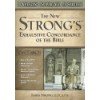 | Amazon |
| The NIV Exhaustive Bible Concordance; covers every word in the NIV, 1,600+ pages | 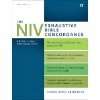 | Amazon |
| The Strongest NASB Exhaustive Concordance; Over 400,000 entries | 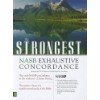 | Amazon |
| ESV Exhaustive Concordance; more than 340,000 entries | 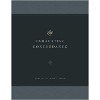 | Amazon |
| KJV Super Giant-Print Dictionary & Concordance; giant print | 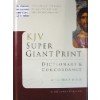 | Amazon |
| The Strongest Strong’s Exhaustive Concordance; classic version with larger type | 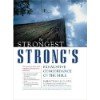 | Amazon |
| Young’s Analytical Concordance to the Bible; Over 300,000 entries | 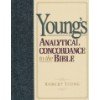 | Amazon |
Also see Study Bible vs Regular Bible: What’s the Difference? to learn more.
Top 5 Bible dictionaries
| Title / Description | Check price |
|---|---|
| Vine’s Complete Expository Dictionary of Old and New Testament Words | Amazon |
| Strong’s Concise Concordance And Vine’s Concise Dictionary Of The Bible | Amazon |
| The New Unger’s Bible Dictionary | Amazon |
| Zondervan Illustrated Bible Dictionary | Amazon |
| Nelson’s Illustrated Bible Dictionary | Amazon |
| New Bible Dictionary | Amazon |
| NIV Dictionary of the Bible | Amazon |
For even more Bible concordances, see What’s a Bible Concordance? which includes a comparison chart.
Bible concordance: example entry
If a person wanted to do a biographical study on Aaron, Moses’ brother, they would look his name up in the “A” section of a concordance and find a listing similar to this:
AARON (318) [Aaron’s, Aaronic]
Beneath this basic information is the list of occurrences organized according to the book title, chapter and verse location, and a few words of context. Often, only the first letter of the subject is printed, and the letter is in bold type.
Ex. 4:14 “What about your brother, A the Levite? 195
Ex. 4:27 The Lord said to A, “Go into the desert 195
Ex. 4:28 Then Moses told A everything 195
Some concordances provide an additional number (e.g., “195”) that corresponds with a Hebrew or Greek dictionary, also called a lexicon. If this is the case, the introduction to the concordance will explain what lexicon the numbers are associated with.
If someone looks up the number in the proper lexicon, they can read the Hebrew or Greek definition of the word without having any knowledge of those languages.
Bible dictionary: example
If a person wanted to study the word “manna,” they would turn to the “M” section in a Bible dictionary and find an entry like this:
The entry for “manna” in this Bible dictionary provides the language of origin – Hebrew; the pronunciation – man-hu; the literal meaning of the word – “What is that?”; followed by how the word is used in the bible.
Hebrew. man-hu, “What is that?” is the name given by the Israelites to the food miraculously supplied to them during their wanderings in the wilderness ( Exodus 16:15-35 ).
The name is commonly taken as derived from man, an expression of surprise, “What is it?” but more probably, it is derived from manan, meaning “to allot,” and hence denoting an “allotment” or a “gift.”
This “gift” from God is described as “a small round thing,” like the “hoar-frost on the ground,” and “like coriander seed,” “of the colour of bdellium,” and in taste “like wafers made with honey.” It was capable of being baked and boiled, ground in mills, or beaten in a mortar (Exodus 16:23; Numbers 11:7).
If any was kept over till the following morning, it became corrupt with worms; but as on the Sabbath none fell, on the preceding day a double portion was given, and that could be kept over to supply the wants of the Sabbath without becoming corrupt.
Directions concerning the gathering of it are fully given (Exodus 16:16-18, Exodus 16:33; Deuteronomy 8:3, Deuteronomy 8:16).
It fell for the first time after the eighth encampment in the desert of Sin, and was daily furnished, except on the Sabbath, for all the years of the wanderings, till they encamped at Gilgal, after crossing the Jordan, when it suddenly ceased, and where they “did eat of the old corn of the land; neither had the children of Israel manna any more” (Joshua 5:12). They now no longer needed the “bread of the wilderness.”
This manna was evidently altogether a miraculous gift, wholly different from any natural product with which we are acquainted, and which bears this name.
The manna of European commerce comes chiefly from Calabria and Sicily. It drops from the twigs of a species of ash during the months of June and July. At night it is fluid and resembles dew, but in the morning it begins to harden.
The manna of the Sinaitic peninsula is an exudation from the “manna-tamarisk” tree (Tamarix mannifera), the el-tarfah of the Arabs. This tree is found at the present day in certain well-watered valleys in the peninsula of Sinai.
The manna with which the people of Israel were fed for forty years differs in many particulars from all these natural products.
Our Lord refers to the manna when he calls himself the “true bread from heaven” (John 6:31-35 ; 4851 -51). He is also the “hidden manna” (Revelation 2:17; Compare John 6:49, John 6:51).
See What is a Devotional Bible? to learn about a Bible study resource intended for daily reading.
Also see:
Reference Bibles vs. Study Bibles
Related Articles
Charles Ryrie vs. C.I. Scofield Study Bible: What's the Difference?
The Scofield Study Bible and the Ryrie Study Bible are two of the last century's most popular Christian reference resources. There are similarities between the Study Bibles because both men were...
There are different types of Bible commentaries because the people who use them have different needs and purposes. Some readers are scholars, others are pastors, and still others are Christians...
